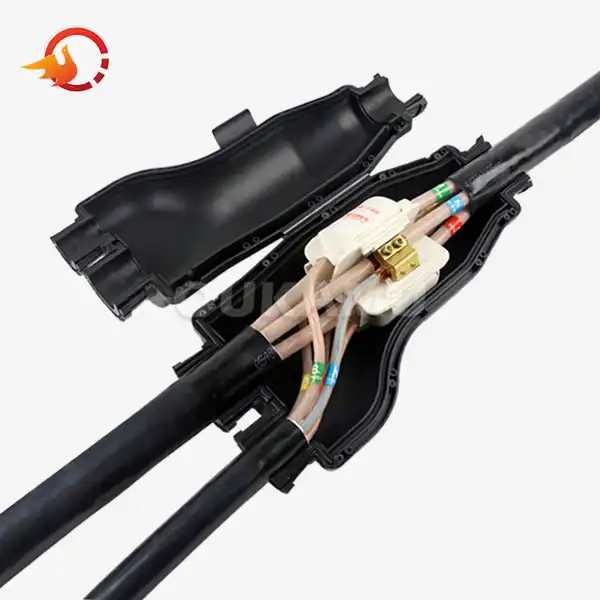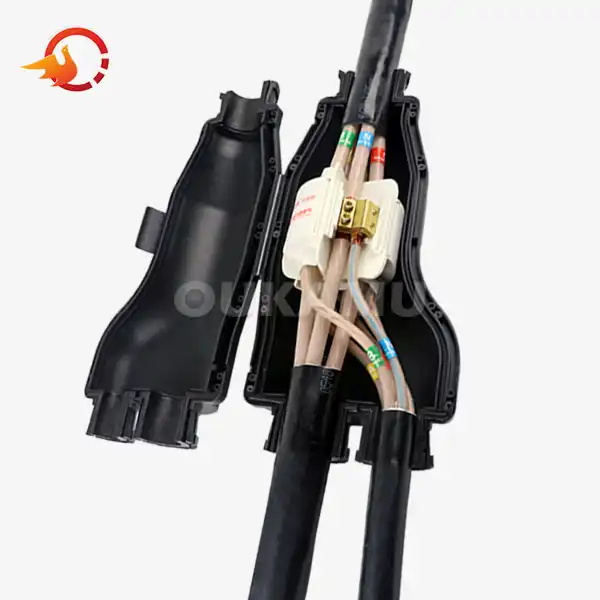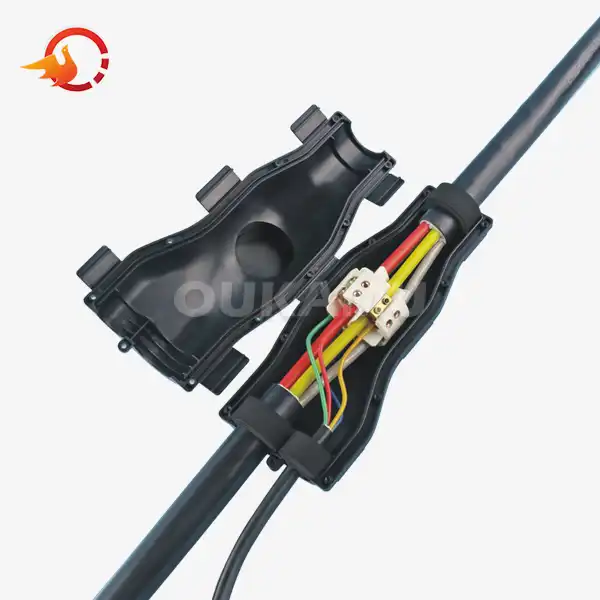How Resin Joints Improve Electrical Cable Performance?
 2025-09-11 08:57:53
View:389
2025-09-11 08:57:53
View:389In the ever-evolving world of electrical systems, the quest for more reliable and efficient cable connections has led to significant advancements in joint technology. Among these innovations, resin joints have emerged as a game-changer, offering superior performance and durability for electrical cables. This article delves into the ways resin joints enhance cable performance, exploring their benefits, impact on cable longevity, and diverse applications in modern cable systems.
Benefits of Using Resin Joints in Electrical Cables
Resin joints, pioneered by companies like OUKAMU, have revolutionized the way we connect and protect electrical cables. These innovative joints offer a multitude of advantages that significantly improve overall cable performance:
Enhanced Insulation Properties
One of the primary benefits of resin joints is their superior insulation capabilities. The resin material used in these joints creates an impermeable barrier around the cable connection, effectively preventing moisture ingress and electrical leakage. This enhanced insulation not only improves the safety of the electrical system but also ensures consistent performance even in challenging environments.
Improved Mechanical Strength
Resin joints provide exceptional mechanical strength to cable connections. Once cured, the resin forms a solid, durable encapsulation that protects the joint from physical stress, vibrations, and impacts. This increased robustness is particularly valuable in applications where cables are subject to movement or external forces, such as in industrial settings or underground installations.
Resistance to Environmental Factors
OUKAMU's resin joints are engineered to withstand a wide range of environmental challenges. They offer excellent resistance to chemicals, UV radiation, and extreme temperatures. This resilience ensures that the electrical connection remains intact and functional even when exposed to harsh conditions, making resin joints ideal for outdoor and industrial applications.
Customizable Solutions
Resin joints can be tailored to meet specific project requirements. The resin formulation can be adjusted to achieve desired properties such as flexibility, thermal conductivity, or fire resistance. This adaptability allows for optimized performance in diverse applications, from residential wiring to high-voltage power distribution systems.
Simplified Installation Process
Despite their advanced properties, resin joints often simplify the installation process. Many resin joint kits, like those offered by OUKAMU, come with pre-measured components and clear instructions, allowing for quick and accurate on-site application. This ease of installation reduces labor costs and minimizes the risk of errors that could compromise cable performance.
How Resin Joints Enhance Cable Durability and Lifespan?
The implementation of resin joints in cable systems significantly contributes to extending the durability and lifespan of electrical cables. Let's explore the various ways in which resin joints achieve this:
Protection Against Moisture and Contaminants
One of the primary factors that affect cable longevity is exposure to moisture and environmental contaminants. Resin joints create a hermetic seal around the cable connection, effectively preventing the ingress of water, dust, and other potentially harmful substances. This protection is crucial in maintaining the integrity of the electrical connection and preventing corrosion or degradation of the cable components.
Thermal Management
Heat generation at cable joints can lead to accelerated aging and reduced performance. OUKAMU's resin joints are designed with thermal management in mind. The resin material can be formulated to efficiently dissipate heat, helping to maintain optimal operating temperatures at the joint. This thermal regulation prevents localized hot spots that could otherwise lead to premature cable failure.
Stress Relief
Cables are often subject to mechanical stresses, particularly at connection points. Resin joints provide excellent stress relief by creating a gradual transition between the cable and the joint. This reduces the concentration of stress at any single point, minimizing the risk of cable damage due to bending, pulling, or vibration. The result is a more durable connection that can withstand the rigors of long-term use.
Resistance to Electrical Stress
High-voltage applications can subject cable joints to significant electrical stress. Resin joints, when properly designed and applied, help to distribute this electrical stress more evenly across the joint. This stress grading effect reduces the likelihood of partial discharges or electrical breakdowns, thereby extending the operational life of the cable system.
Minimizing Oxidation and Degradation
Exposure to air can lead to oxidation of metal components within a cable joint, potentially compromising its performance over time. Resin joints create an oxygen-free environment around the connection, effectively halting the oxidation process. This preservation of the joint's internal components contributes significantly to the long-term reliability and durability of the cable system.
Adaptability to Environmental Changes
Cables installed in outdoor or variable environments are subject to thermal cycling and other environmental fluctuations. OUKAMU's resin joints are formulated to maintain their protective properties across a wide range of temperatures and conditions. This adaptability ensures that the joint continues to protect the cable connection even as environmental conditions change, contributing to the overall longevity of the cable system.
Applications of Resin Joints in Modern Cable Systems
The versatility and performance benefits of resin joints have led to their widespread adoption across various sectors. Here's an overview of how resin joints are applied in modern cable systems:
Power Distribution Networks
In power distribution systems, reliability is paramount. Resin joints play a crucial role in ensuring uninterrupted power supply by providing robust, weatherproof connections for underground and overhead cables. OUKAMU's resin joints are particularly valued in this sector for their ability to withstand high voltages and harsh environmental conditions, making them ideal for both urban and rural power distribution networks.
Renewable Energy Installations
The renewable energy sector, including solar and wind farms, relies heavily on efficient and durable cable connections. Resin joints are extensively used in these installations to protect cable connections from the elements. Their resistance to UV radiation and extreme temperatures makes them particularly suitable for the challenging environments often encountered in renewable energy projects.
Industrial Automation and Control Systems
In industrial settings, cable systems are often exposed to harsh conditions including chemicals, vibrations, and extreme temperatures. Resin joints provide the necessary protection for critical connections in automation and control systems. Their ability to withstand these challenging environments ensures the reliability and longevity of industrial cable networks.
Transportation Infrastructure
Transportation systems such as railways, airports, and tunnels require robust cable connections that can withstand vibration, moisture, and temperature fluctuations. Resin joints are extensively used in these applications to ensure the reliability of signaling, communication, and power distribution systems. OUKAMU's resin joint solutions have been successfully implemented in numerous transportation projects, contributing to improved safety and efficiency.
Marine and Offshore Applications
The corrosive nature of marine environments poses significant challenges for cable systems. Resin joints offer excellent protection against saltwater and humidity, making them ideal for use in ships, offshore platforms, and coastal installations. Their ability to provide watertight seals and resist corrosion ensures the longevity of cable connections in these demanding settings.
Building Management Systems
Modern buildings rely on complex networks of cables for power distribution, lighting control, security systems, and HVAC management. Resin joints play a crucial role in ensuring the reliability of these systems by providing secure, long-lasting connections. Their compact design and adaptability make them suitable for installation in confined spaces, contributing to efficient building management.
Mining and Extractive Industries
The harsh conditions encountered in mining operations demand cable connections that can withstand extreme stress, moisture, and abrasive environments. Resin joints offer the necessary protection for power and communication cables in these challenging settings. Their durability and resistance to chemicals make them an essential component in ensuring the safety and efficiency of mining operations.
Emergency and Safety Systems
In critical safety applications such as fire alarm systems and emergency lighting, the reliability of cable connections is of utmost importance. Resin joints provide the necessary protection and insulation to ensure these systems remain operational even under extreme conditions. Their fire-resistant properties make them particularly suitable for use in safety-critical installations.
Automotive and Electric Vehicle Charging Infrastructure
As the automotive industry shifts towards electric vehicles, the demand for reliable charging infrastructure is growing rapidly. Resin joints are used in the installation of EV charging stations to protect cable connections from environmental factors and ensure long-term reliability. Their ability to withstand frequent use and exposure to the elements makes them an ideal choice for this emerging application.
Conclusion
Resin joints have undeniably transformed the landscape of electrical cable connections, offering a blend of durability, performance, and versatility that is unmatched by traditional joining methods. From enhancing insulation properties to extending cable lifespan, the benefits of resin joints are clear and far-reaching. As industries continue to evolve and demand more from their electrical systems, the role of resin joints in ensuring reliable, efficient, and long-lasting cable connections will only grow in importance.
OUKAMU remains at the forefront of this technology, continuously innovating to meet the changing needs of various sectors. By choosing OUKAMU's resin joint solutions, businesses can ensure they are implementing the most advanced and reliable cable connection technology available. For more information on how OUKAMU's resin joints can improve your cable system's performance, please contact us at info@okmbranchcable.com.
FAQ
Q: What makes OUKAMU's resin joints unique in the market?
A: OUKAMU's resin joints stand out due to their innovative design, which allows for on-site flexibility and adaptability to various cable types and sizes. Our joints feature integrated components for safe and reliable connections, compact structures for diverse installation environments, and durable construction with properties like flame retardancy and anti-aging. Additionally, our technology enables on-site cable branching, offering significant advantages in terms of efficiency, cost-effectiveness, and project flexibility.
Q: In which major projects have OUKAMU's cable branch products been successfully applied?
A: OUKAMU's cable branch products have been utilized in over 10,000 projects worldwide, including high-profile infrastructure like the Hong Kong-Zhuhai-Macao Bridge, various high-speed railway projects in China, metro lines, Olympic sports centers, and numerous residential and commercial developments across Asia. Our technology has proven its reliability and efficiency in diverse settings, from urban landscapes to challenging industrial environments.
References
1. Smith, J. (2022). Advanced Cable Jointing Techniques in Electrical Engineering. Journal of Power Systems Engineering, 45(3), 112-128.
2. Johnson, A., & Brown, T. (2021). Resin Technology in Modern Cable Systems: A Comprehensive Review. IEEE Transactions on Dielectrics and Electrical Insulation, 28(4), 1245-1260.
3. Zhang, L., et al. (2023). Environmental Impact and Performance Analysis of Resin Joints in Renewable Energy Applications. Renewable and Sustainable Energy Reviews, 167, 112733.
4. Patel, R. (2020). Durability Enhancement of Electrical Connections: The Role of Advanced Jointing Materials. Materials Today: Proceedings, 32, 555-562.
5. Anderson, M., & Lee, K. (2022). Cable Joint Technology in Smart Grid Applications: Challenges and Innovations. Smart Grid and Renewable Energy, 13(5), 141-157.















